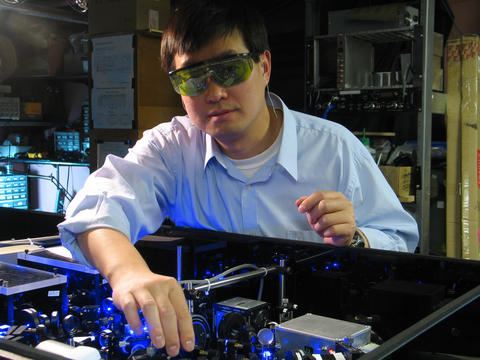
NIST physicist Jun Ye adjusts the laser setup for a strontium atomic clock in his laboratory at JILA, a joint institute of NIST and the University of Colorado at Boulder.
BOULDER, Colo.—Physicists have measured and controlled seemingly forbidden collisions between neutral strontium atoms—a class of antisocial atoms known as fermions, which are not supposed to collide when in identical energy states. The advance makes possible a significant boost in the accuracy of atomic clocks based on hundreds or thousands of neutral atoms.
Described in the April 17 issue of the journal Science, the research was performed at JILA, a joint institute of the National Institute of Standards and Technology (NIST) and the University of Colorado (CU) at Boulder.
"This is one of the most precise measurements of collisional effects in a clock," says NIST/JILA Fellow Jun Ye, whose strontium atomic clock design enables scientists to "peek into very tiny effects."
The new techniques make JILA's strontium clock 50 percent more accurate than the results reported last year, so that it now would neither gain nor lose 1 second in more than 300 million years. The method could also be applicable to many other atomic clocks based on neutral atoms.
Co-authors of the paper include scientists from nearby NIST Boulder, who provided signals from a calcium atomic clock via fiber-optic cable to serve as the "ruler" for the JILA measurements, and a NIST theorist from the Joint Quantum Institute in Maryland, who helped explain why the collisions occur.
JILA's strontium clock is one of several next-generation atomic clocks under development around the world. These experimental clocks are based on a variety of different atoms and designs, from single ions (electrically charged atoms) to thousands of neutral atoms; it is not yet clear which design will emerge as the best and be chosen as the future international time standard. The latest JILA work helps eliminate a significant drawback to clock designs based on ensembles of neutral atoms. The presence of many atoms increases both the precision and signal of a clock based on the oscillations between energy levels, or "ticks," in those atoms. However, uncontrolled interactions between atoms can perturb their internal energy states and shift the number of clock ticks per second, reducing overall accuracy.
Fermions, according to the rules of quantum physics, cannot occupy the same energy state and location in space at the same time. Therefore, fermions, such as a collection of identical strontium atoms, are not supposed to collide. However, as Ye and his research group improved the performance of their strontium clock over the past two years, they began to observe small shifts in the frequencies of the clock ticks due to atomic collisions. The extreme precision of their clock unveiled in 2008 enabled the group to measure these minute interactions systematically, including the dynamic effect of the measurement process itself, and to significantly reduce the resulting uncertainties in clock operation.
"There's a fundamental question here: Why do fermions actually collide?" Ye asks. "Now we understand why there is a frequency shift, and we can zero the shift ... [This result] does not change theory. The value is from the practical possibilities: We can control multi-particle interactions."
The JILA clock used in the latest experiments contains about 2,000 strontium atoms cooled to temperatures of a few microKelvin (a few millionths of a degree above absolute zero) and trapped in multiple levels of a crisscrossed pattern of light, known as an optical lattice. The lattice is shaped like a tall stack of pancakes, or wells. About 30 atoms are grouped together in each well, and these neighboring atoms sometimes collide.
Ye's group discovered that two atoms located some distance apart in the same well are subjected to slight variations in the direction of the laser pulses used to boost the atoms from one energy level to another. The non-uniform interaction with light excites the atoms unevenly. Strontium atoms in different internal states are no longer completely identical, and become distinguishable enough to collide, if given a sufficient amount of time. This differential effect can be suppressed by making the atoms even colder or increasing the trap depth.
The probability of atomic collisions depends on the extent of the variation in the excitation of the ensemble of atoms. Significantly for clock operations, the JILA scientists determined that when the atoms are excited to about halfway between the ground state and the more energetic excited state, the collision-related shifts in the clock frequencies goes to zero. This knowledge enables scientists to reduce or even eliminate the need for a significant correction in the clock output, thereby increasing accuracy.
The discoveries described in Science also would apply to clocks using atoms known as bosons, which, unlike fermions, can exist in the same place and energy state at the same time. This category of clocks includes NIST-F1, which is operated by NIST Boulder as the U.S. civilian time and frequency standard. In the case of bosons, variations in light-matter interactions would reduce (rather than increase) the probability of collisions.
Beyond atomic clocks, the high precision of JILA's strontium lattice experimental setup is expected to be useful in other applications requiring exquisite control of atoms, such as quantum computing—potentially ultra-powerful computers based on quantum physics—and simulations to improve understanding of other quantum phenomena such as superconductivity.
The research described in Science was supported by NIST, the National Science Foundation, the Office of Naval Research and the Defense Advanced Research Projects Agency. A visiting professor at JILA from the Niels Bohr Institute in Denmark made important contributions helping to explain why the collisions occur. Ye is also a professor adjoint of physics at CU.
Additional Contact: caughey [at] colorado.edu (Peter Caughey), 303-492-4007
G.K. Campbell, M.M. Boyd, J.W. Thomsen, M.J. Martin, S. Blatt, M.D. Swallows, T.L. Nicholson, T. Fortier, C.W. Oates, S.A. Diddams, N.D. Lemke, P. Naidon, P. Julienne, J. Ye, and A. D. Ludlow. 2009. Probing Interactions between Ultracold Fermions. Science. April 17.

